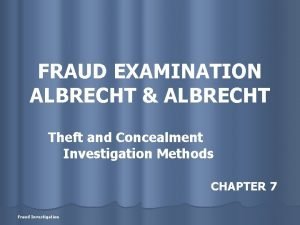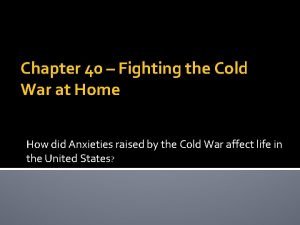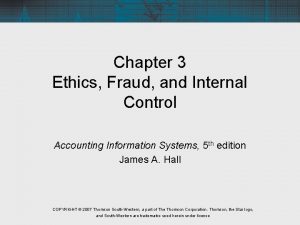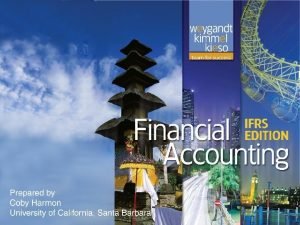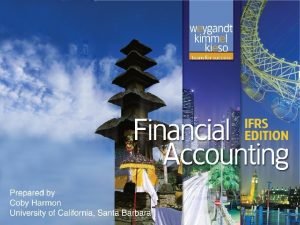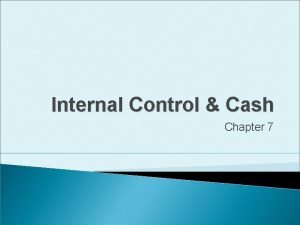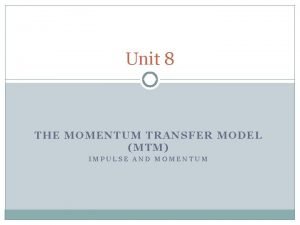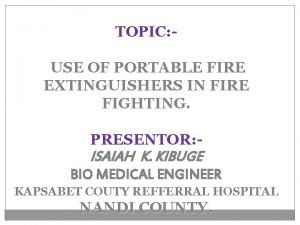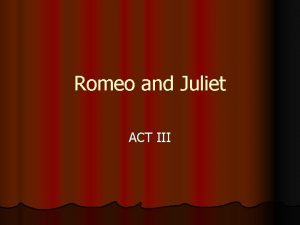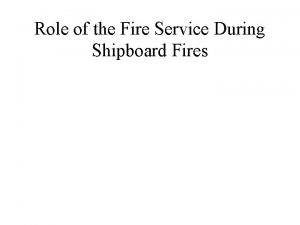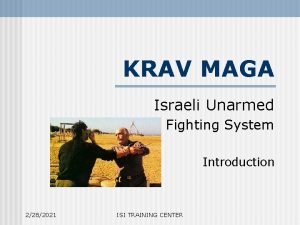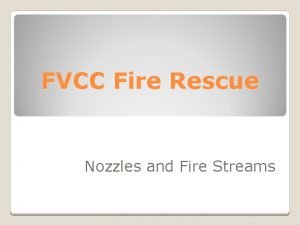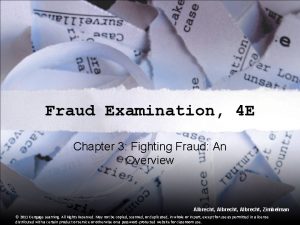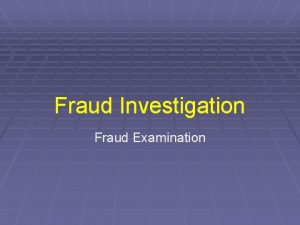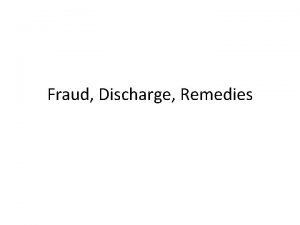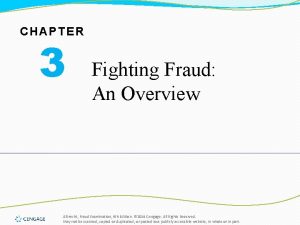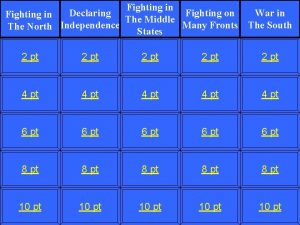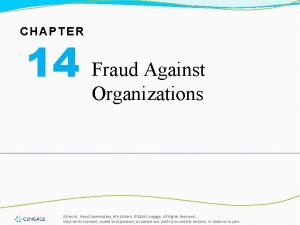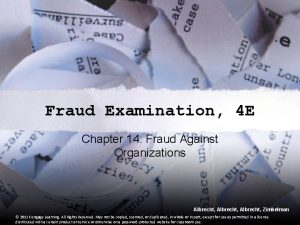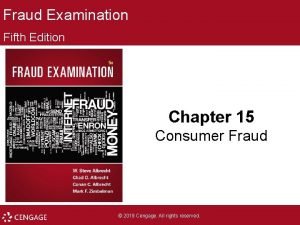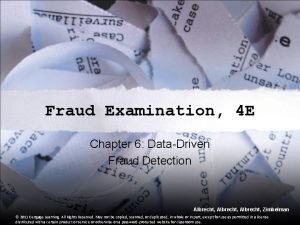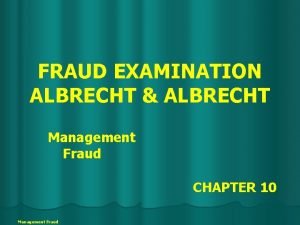Fraud Examination Chapter 3 Fighting Fraud An Overview












- Slides: 12

Fraud Examination Chapter 3 Fighting Fraud: An Overview Albrecht, Zimbelman © 2011 Cengage Learning. All Rights Reserved. May not be copied, scanned, or duplicated, in whole or in part, except for use as permitted in a license

To the Student q You should now understand the various types of fraud and fraudfighting careers as well as those who commit fraud and why they do it. This chapter is a transition chapter to introduce you to the various ways in which organizations deal with fraud. The most cost-effective fraud-fighting activities involve preventing fraud from occurring. q The second most cost-effective fraud-fighting activities involve implementing proactive approaches to detect fraud early, before it has a chance to grow. q Once fraud has been detected (or there is predication that fraud might be occurring), organizations undertake various types of fraud investigation methods. Albrecht, Zimbelman © 2011 Cengage Learning. All Rights Reserved. May not be copied, scanned, or duplicated, in whole or in part, except for use as permitted in a license

To the Student q After fraud has been investigated and the perpetrators are known, various types of legal action are possible. This chapter provides an over view of each of these activities. We then provide detailed coverage of these topics in the later chapters of this book. q Essentially, this chapter provides an overview of the remainder of the book. Albrecht, Zimbelman © 2011 Cengage Learning. All Rights Reserved. May not be copied, scanned, or duplicated, in whole or in part, except for use as permitted in a license

Learning Objectives q Become familiar with the different ways that organizations fight fraud. q Understand the importance of fraud prevention. q Understand how to create a culture of honesty and high ethics. q Understand why hiring the right kind of employees can greatly reduce the risk of fraud. q Understand how to assess and mitigate the risk of fraud. q Understand the importance of early fraud detection. q Understand the different approaches to fraud investigation. q Be familiar with the different options for legal action that can be taken once fraud has occurred. Albrecht, Zimbelman © 2011 Cengage Learning. All Rights Reserved. May not be copied, scanned, or duplicated, in whole or in part, except for use as permitted in a license

How Organizations Fight Fraud Organizations fight fraud by implementing: 1. Fraud prevention 2. Early fraud detection 3. Fraud investigation 4. Legal action and/or resolution Preventing fraud is generally the most cost-effective way to reduce losses from fraud. Albrecht, Zimbelman © 2011 Cengage Learning. All Rights Reserved. May not be copied, scanned, or duplicated, in whole or in part, except for use as permitted in a license

Fraud Prevention Creating a Culture of Honesty & High Ethics Five critical elements: 1. Make sure top management models appropriate behavior 2. Hire the right kind of employees 3. Communicate expectations and require periodic written acceptance to the expectations 4. Create a positive work environment 5. Develop and maintain policies for handling fraud Albrecht, Zimbelman © 2011 Cengage Learning. All Rights Reserved. May not be copied, scanned, or duplicated, in whole or in part, except for use as permitted in a license

Fraud Prevention Eliminate Fraud Opportunities Organizations should: q Identify and measure fraud risks q Implement preventative and detective controls q Create widespread monitoring by employees q Have internal and external auditors Albrecht, Zimbelman © 2011 Cengage Learning. All Rights Reserved. May not be copied, scanned, or duplicated, in whole or in part, except for use as permitted in a license

Early Fraud Detection Three Primary Ways to Detect Fraud 1. By chance 2. By providing “whistle-blowing” systems 3. By data mining In the past, most frauds were detected by accident. Albrecht, Zimbelman © 2011 Cengage Learning. All Rights Reserved. May not be copied, scanned, or duplicated, in whole or in part, except for use as permitted in a license

Fraud Investigation q The first approach to fraud investigation is the evidence square. q How is the evidence square useful in thinking about fraud investigation? Albrecht, Zimbelman © 2011 Cengage Learning. All Rights Reserved. May not be copied, scanned, or duplicated, in whole or in part, except for use as permitted in a license

Fraud Investigation A second approach to fraud investigation is to focus on the two different fraud triangles. Albrecht, Zimbelman © 2011 Cengage Learning. All Rights Reserved. May not be copied, scanned, or duplicated, in whole or in part, except for use as permitted in a license

Follow-Up Legal Action Civil Action Albrecht, Zimbelman © 2011 Cengage Learning. All Rights Reserved. May not be copied, scanned, or duplicated, in whole or in part, except for use as permitted in a license

Follow-Up Legal Action q It is much more difficult to get a criminal conviction than it is to get a judgment in a civil case. Albrecht, Zimbelman © 2011 Cengage Learning. All Rights Reserved. May not be copied, scanned, or duplicated, in whole or in part, except for use as permitted in a license
 How do fraud symptoms help in detecting fraud
How do fraud symptoms help in detecting fraud Concealment investigative methods
Concealment investigative methods Chapter 40 fighting the cold war at home
Chapter 40 fighting the cold war at home Ethics and internal controls in accounting
Ethics and internal controls in accounting Controlsbond
Controlsbond Chapter 7 fraud internal control and cash
Chapter 7 fraud internal control and cash The entry to establish a petty cash fund includes
The entry to establish a petty cash fund includes Momentum bar chart
Momentum bar chart What is starvation in fire fighting
What is starvation in fire fighting Lady capulet goes to tell juliet about the plans
Lady capulet goes to tell juliet about the plans Shipboard fire fighting organization
Shipboard fire fighting organization Israeli fighting system
Israeli fighting system 3 types of fire streams
3 types of fire streams

